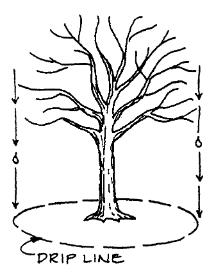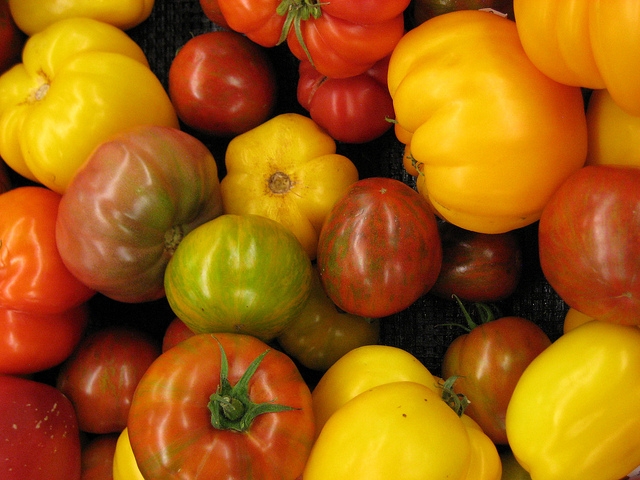Tomato Problems: Walnuts & Soil Borne Diseases
Help for the Home Gardener from the
Contra Costa Master Gardeners' Help Desk
Client's Question:
The client bought 8 different tomato plants from the CCMGs' "Great Tomato Plant Sale". They are withering and dying. The client had previously purchased tomato plants from Navlet's Nursery; she reported that those plants did pretty well. The client observed that the growing season last year and this year were quite different. Each plant was a different variety but each died in a similar way. The plants are in two raised beds, 4' x 8' x 12”. The plants were transplanted from the original containers into gallon pots for two weeks while the bed was being prepared. Each plant was mounded and a base formed around the plants. The tomatoes were watered twice per week, in addition the tomatoes were fed once. The plants did well at first and then one by one they withered and died. The client had recently read about black walnut trees affecting tomatoes adversely, and they wondered if Master Gardeners had more information on that issue. The client has two black walnut trees in close proximity to the raised beds. These trees are in the neighboring yard.
Master Gardener's Response:
The proximity of the black walnut trees to your yard could certainly be contributing to the distress of the tomatoes. However, if the black walnuts are the sole problem, it's hard to understand why you had better success with your tomatoes last year than you've experienced this year. So there may be some other factors at work. We'll first give you some information about how black walnuts affect tomatoes (and certain other plants) and then desccribe some other possible causes for the decline of your tomatoes.
Black Walnuts and Tomatoes: As you noted in your email, black walnut trees produce a substance (called juglone) that is toxic to some plants, including tomatoes. Most of the toxic chemicals accumulate within the drip line of the tree (the area measured from the trunk to the outer reaches of its branches), but some effects of the chemical can extend beyond the drip line to a distance of 50 to 80 feet from the tree. If your tomatoes were planted within the drip line of the walnut trees, the toxic effect of the juglone may be the cause of the decline of the tomatoes (or at least a contributing factor). If the trees are more distant from the tomatoes, it is less likely that juglone is the problem, unless the toxic substance has been introduced into your garden area in some other manner—for example, from the debris from the trees blowing into the garden area or composting tree debris and spreading it in the garden.
If the tomatoes were within drip line of the tree, or if you are aware of other means by which the trees could have contaminated your garden areas, here is a description of the symptoms you would have seen if the problem is juglone toxicity:
"Plants sensitive to juglone may be stunted, have yellow or brown, twisted leaves, exhibit wilting of some or all plant parts, and die over time. Often, the vascular (i.e., water-conducting) tissue of affected plants will be discolored. Symptoms may occur rapidly, even within a few days after sensitive species are transplanted into a walnut tree's root zone. Alternatively, some plants may survive for years near a young walnut tree, but will wilt and die as the tree increases in size."
http://hort.uwex.edu/articles/black-walnut-toxicity
You can find more information about black walnuts and how they affect tomatoes and other sensitive plants at the Wisconsin Cooperative Extension website cited above and in the Washington State University fact sheet at http://bit.ly/1mwaq3A
Other Possible Causes: If your tomatoes are outside the drip zone of the trees, and you aren't aware of other ways that the trees may have contaminated your garden area, you might want to consider other possible causes.
Given that you had better success last year with the tomatoes you purchased at Navlet's, the problem this year may be connected with the varieties of tomatoes you tried to grow. Most of the tomatoes sold at the CCMG tomato sale are heirloom variety tomatoes. The ones you purchased last year were likely hybrid varieties which are common in commercial nurseries. If successfully grown, heirloom tomatoes often give you a better flavor than many hybrid tomatoes. Also, if you save seeds from a heirloom variety, the seeds will produce the same variety of tomato plant while seeds saved from a hybrid will not reliably grow the same plant variety in future years. The downside is that many heirlooms have less disease resistance than hybrid tomatoes.
Some common plant diseases that affect non-resistant tomato varieties are caused by soil borne pathogens that build up over the years in the soil. To minimize the chances that such pathogens will be present, crop rotation is a must. If you planted your tomatoes in the same spot as last year, then such problems are more likely to occur. It is best to use at least a three-year crop rotation cycle and not plant tomatoes (or other members of the same plant family such as peppers, potatoes, and eggplant) more than two years consecutively in the same garden bed and not plant other solanaceae plants (egg plant, peppers, potatoes, etc.) in the other years.
If you plan to try growing tomatoes again in the same garden area, and you are unable to practice crop rotation, be sure you buy or grow tomatoes that have some disease resistance. As mentioned above, you are most likely to find disease resistance in hybrid varieties. The plant label or seed package of disease resistant varieties will be labeled with codes for the diseases for which some resistance exists. Here's a list of the Codes and the tomato disease represented by each of the code letters:
Tomato disease resistance codes:
| Resistance Code |
Disease | Resistance Code |
Disease |
| V | Verticillium Wilt | A | Alternaria |
| F | Fusarium Wilt | T | Tobacco Mosaic Virus |
| FF | Fusarium, races 1 and 2 | St | Stemphylium (Gray Leaf Spot) |
| FFF | Fusarium, races 1, 2, and 3 |
TSWV | Tomato Spotted Wilt Virus |
| N | Nematodes |
Most varieties will only be resistant to some of these diseases. Look particularly for resistance to verticillium and fusarium wilt which are common in our county. Nematodes can be a problem also. The UC publication at http://www.ipm.ucdavis.edu/PMG/GARDEN/VEGES/tomato.html may possibly help you identify what disease could be affecting your tomatoes. Providing us with a sample and/or pictures would help us assist you.
If you suspect that soil borne diseases could have been the problem, perhaps next year you might try growing an heirloom tomato variety in a container, using a purchased soil mix which is unlikely to contain soil borne diseases. The purchased soil mixture in the container would also be unlikely to be contaminated with juglone, particularly if you position the container as far as possible away from the black walnut trees and keep any debris from the trees from falling into the container. If you decide to try growing a tomato in a container, use a container that is at least 16 inches deep. Cherry tomatoes or other varieties that produce smaller sized tomatoes usually do well in containers. “Determinate” varieties also do better than “indeterminate” varieties in containers. Look on the plant labels or seed packages to find determinate varieties. (We sell many determinate varieties at our annual tomato plant sale.)
Here's hoping that next year's varieties will prove fruitful and tasty tomatoes.
Contra Costa Master Gardeners' Help Desk
Editor's Note: The CCMG Help Desk is available year-round to answer your gardening questions. Except for a few holidays, we're open every week, Monday through Thursday from 9:00 am to Noon at 75 Santa Barbara Road, 2d Floor, Pleasant Hill, CA 94523. (map) We can also be reached via telephone: (925) 646-6586, email: ccmg@ucanr.edu, and we are on the web at http://ccmg.ucanr.edu/. "Ask a Master Gardener" help tables are also present at many Farmers Markets as well as at the CCMG's "Our Garden" programs (map). See the CCMG web page for details/locations.
Comments:
Those comments about allelopathy are almost always related to root/soil pathways. On the other hand, some rather skimpy information I found would seem to indicate that the leaf and litter (i.e., something close to "mulch") from allelopathic plants can have similar impacts, especially black walnut and probably eucalyptus.
One reference I found "Impact of Mulches on Landscape Plants" at http://ucanr.edu/sites/UrbanHort/files/80212.pdf... stated in part
"Allelopathy.
Properly applied landscape mulch will not have allelopathic effects on established landscape plants. It is most likely to injure newly planted or shallow rooted plants. A short period of composting and correct application of woody mulch will prevent damage."
Realizing that not all plants exhibit allelopathic effects, I think that to be on the safe side you should consider the quote above and keep the potted plants clear of black walnut leat litter, etc. and if mulch is needed use from another source other than the black walnut. However, it does appear, used cautiously, well-composted mulch should minimize and/or eliminate the problem. Considering that potted plants don't usually require a lot of mulch and/or compost, I would use some other source of mulch and/or compost. Possibly the use of "other" mulch could also protect from the allelopathic black walnut leaves from accumulating on the soil and potentially causing impacts.
Hopefully, that answers your concerns. If not, please do not hesitate to submit more questions.
CHEERS











An interesting update from the Garden Professors BLOG on walnut alleopathy and the use of walnut chips for mulch...
see <http://blogs.extension.org/gardenprofessors/> the blog from Linda Chalker-Scott dated October 1st...calls to question the actual impact of walnuts... specifically what and when the impact is a problem...
Posted by Stephen I Morse on October 1, 2014 at 1:57 PM